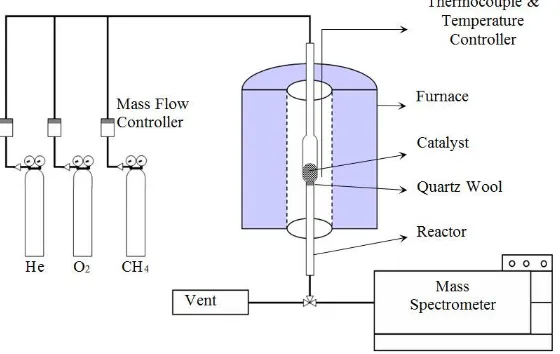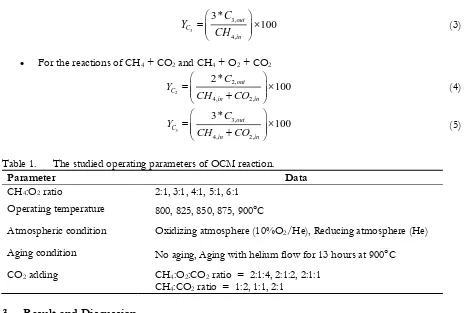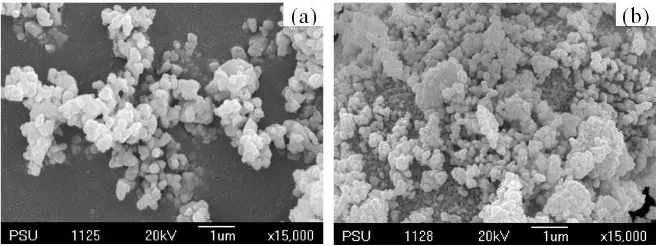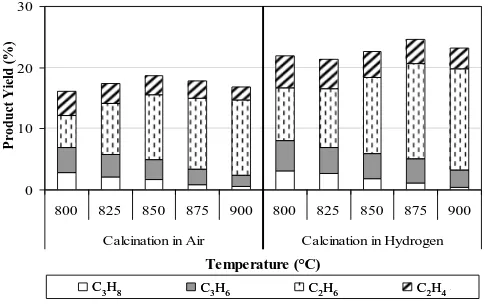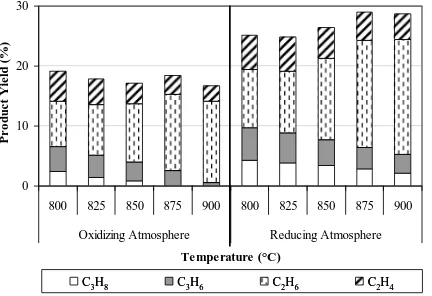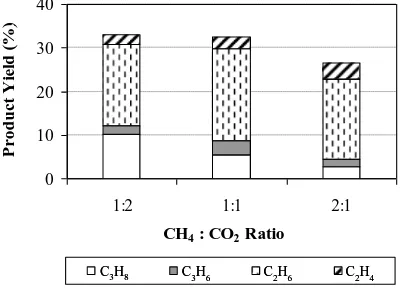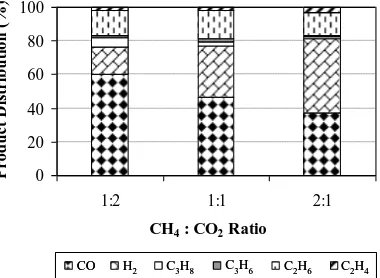Article
Reactivity of Au/La
1-x
Sr
x
Cr
1-y
Ni
y
O
3-
toward Oxidative
Coupling of Methane for C
2
and C
3
Hydrocarbons
Production
Hatairat Worraphon
1, Wisitsree Wiyaratn
2,*
, Suttichai Assabumrungrat
3,
and Navadol Laosiripojana
11 The Joint Graduate School of Energy and Environment, CHE Center for Energy Technology and Environment, King Mongkut’s University of Technology Thonburi, Bangkok, 10140, Thailand
2 Faculty of Industrial Education and Technology, King Mongkut’s University of Technology Thonburi, Bangkok, 10140, Thailand
3Centre of Excellence in Catalysis and Catalytic Reaction Engineering, Department of Chemical Engineering, Faculty of Engineering, Chulalongkorn University, Bangkok 10330, Thailand
*E-mail: Wisitsree.Wiy@kmutt.ac.th (Corresponding author)
Abstract. La0.8Sr0.2Cr0.9Ni0.1O3 (LSCN) perovskite was calcined in hydrogen atmosphere (LSCN-H2) that provides better activity than LSCN-air. The doping of Au (as Au/LSCN-H2) improved the catalyst stability toward oxidativecoupling of methane (OCM) reaction by increasing the resistance of carbon formation on catalyst surface during the reaction. The suitable CH4:O2 ratio appeared to be 2:1, from which 5.8%, 29.9%, 8.1%, and 5.8% of C2H4, C2H6, C3H6, and C3H8 can be produced respectively. Importantly, the addition of CO2 can significantly promote the yield of C3H8 produced, from which the suitable CH4:CO2 ratio was observed to be 1:2 (with or without O2 presenting).
Keywords: LSCN Perovskite, gold, oxidative coupling of methane.
ENGINEERING JOURNAL Volume 18 Issue 4 Received 5 April 2013
1.
Introduction
Lacking of fossil fuels and the current global warming crisis drive the researchers to find new energy resources, which are of high efficiency and environmental friendly. Solid oxide fuel cell (SOFC) is known as an energy device that can generate clean electrical energy with high efficiency for power generation application. Nevertheless, the main barrier of SOFC is its high investment cost, which results in the expensive electricity production. Therefore, the new approach for SOFC operation by integrating the electricity generation with high-value chemical synthesis as called “SOFC cogeneration with chemical production” is currently of interest [1, 2].
It is known that, along with hydrogen (H2) and synthesis gas (the mixture of CO and H2), the most interesting primary fuel for SOFC is methane (CH4) because it is an abundant component in conventional natural gas and could be internally reformed at the anode side of SOFC, as called Direct Internal Reforming (DIR) operation. Importantly, it is well established that CH4 can also be converted to valuable chemicals such as C2 hydrocarbons (ethylene and ethane), which are useful chemical compounds in petrochemical industries via the oxidativecoupling of methane (OCM) reaction [3, 4]. Therefore, the integration of SOFC cogeneration for electricity generation and C2 hydrocarbons production via OCM reaction is an attractive approach for reducing the total cost of electricity generation [5-7]. It is well established that the use of suitable catalyst at the electrode of SOFC is the key issue for achieving the good SOFC cogeneration performance. Recently, several types of catalyst for OCM reaction have been studied and reported, from which the suitable catalysts for this reaction include SrF2/Nd2O3, Mn/Na2WO4/SiO2, La2O3, LaAlO3, LaCoO3,LaCrO3, BaxSr1-xTiO3, SrTi1-xLixO3 and Au/LSM [8-17]. Among these catalysts, the use of perovskite material (ABO3) as the catalyst as well as the support for the OCM reaction has been widely reported to enhance the good activity in term of product yield and product selectivity [18-27]. Importantly, the properties of perovskite material can tolerate a wide variety of composition and constituent elements by the main structure unchanged; hence perovskite material has the possibility to improve the properties by partial substitution of cations and can be used at high temperature conditions. Among perovskite material, LaCrO3-based perovskite material has been widely investigated for SOFC applications i.e. as an anode component and as an internal reforming catalyst. Nevertheless, it is well known that pure lanthanum chromite shows a decrease in mechanical strength under reducing conditions as well as phase segregation in the microstructure due to the evaporation of gaseous CrO3 from LaCrO3 particles at high temperature; the partial substitution of Cr on the B-site by Ni (Cr/Ni of 0.9/0.1) has been reported to improve the structural stability without a significant decrease in its catalytic reactivity. Furthermore, the partial substitution of the A-site cation with alkaline earths (i.e., Sr) has been found to increase the catalytic reactivity of LaCrO3 -based perovskite material due to the stabilizing of the B-site cation as well as the introducing of structural defects e.g., oxygen vacancies. Therefore, La1-xSrxCr1-yNiyO3- was selected as the catalyst for OCM reaction in the present work. In addition, the effect of gold (Au) doping over La1-xSrxCr1-yNiyO3-on the OCM performance was also investigated since it is known that Au can promote the catalytic activity of various thermochemical reactions.
In the present work, La1-xSrxCr1-yNiyO3- was synthesized by co-precipitation techniques, which enables to produce the material with nano-particle size and high surface area. The effects of Au doping as well as the catalyst pretreatment condition (i.e. calcination in air and/or hydrogen) on the catalytic OCM activity under various conditions were performed.
2.
Experimental
2.1. Catalyst Preparation and Characterization
20C·min-1. Then 3 wt% Au of HAuCl4 (Tetrachloroauric (III) acid) was deposited on La0.8Sr0.2Cr0.9Ni0.1O3perovskite by deposition-precipitation technique integrated with ultrasound in an ultrasonic bath for 6 hours. The dispersion was filtered, washed with deionized water until pH equal to 7, and dried at 100C. Finally, the dried sample was heated at 300C for 4 hours in air atmosphere.
The synthesized catalysts were determined their physical properties by various techniques. Surface area and pore size were determined by BET method. The crystalline phase was identified by X-Ray Diffraction (XRD). Scanning Electron Microscopy (SEM) was also used to examine the surface morphology of synthesized catalyst and gold particle size was determined by Transmission Electron Microscopy (TEM).
2.2. Catalytic Activity Testing
A schematic diagram of the experimental system of OCM is shown in Fig. 1. This system was constructed with three main sections i.e., supplied gases, reaction zone, and analysis section. The supplied gases were composed of 99.99% helium, 5% methane, and 10% oxygen diluted in helium. They were used without further purification. The ratio of mixing gases depended on the purpose of each experiment.
Fig. 1. Schematic diagram of oxidative coupling of methane system
.
The reaction was carried out in a tubular quartz reactor filled with 100 mg of selected sample and small amount of quartz wool. The reactor was vertically mounted inside a furnace. Gas mixture between methane and oxygen diluted in helium were allowed to continually flow into the reaction zone at a total flow rate 200 cm3·min-1. The reactions were studied in temperature range of 800-900C (heating rate of 20°C·min-1) and held around 3 hours until equilibrium was reached. The study of OCM is shown in Table 1. It is noted that the effects of CH4:O2 inlet ratio and carbon dioxide (CO2) addition on the catalytic performance were also determined. After reaction, the composition of effluent gas was analyzed by an online mass spectrometer (Pfeiffer Vacuum; OmnistarTM GSD 301). In the present work, the catalytic performance was evaluated in terms of reactant conversion and product yields using the following equations:
Conversion of reactants
100
in out
R
in
R R
X
R
(1)
where R is concentration of CH4, O2, or CO2 Product yields
For the reaction of CH4 + O2
2
2,
4,
2 *
100
out C
in C Y
CH
[image:3.595.169.449.289.466.2]3
3,
4,
3*
100
out C
in C Y
CH
(3)
For the reactions of CH4 + CO2 and CH4 + O2 + CO2
2
2,
4, 2,
2 *
100
out C
in in
C Y
CH CO
(4)
3
3,
4, 2,
3*
100
out C
in in
C Y
CH CO
[image:4.595.66.530.73.386.2] (5)
Table 1. The studied operating parameters of OCM reaction.
Parameter Data
CH4:O2 ratio 2:1, 3:1, 4:1, 5:1, 6:1 Operating temperature 800, 825, 850, 875, 900C
Atmospheric condition Oxidizing atmosphere (10%O2/He), Reducing atmosphere (He)
Aging condition No aging, Aging with helium flow for 13 hours at 900C CO2 adding CH4:O2:CO2 ratio = 2:1:4, 2:1:2, 2:1:1
CH4:CO2 ratio = 1:2, 1:1, 2:1
3.
Result and Discussion
3.1. Catalyst characteristics
The prepared materials consisted of La0.8Sr0.2Cr0.9Ni0.1O3 calcined under air atmosphere (LSCN-air), La0.8Sr0.2Cr0.9Ni0.1O3 calcined under hydrogen atmosphere (LSCN-H2), Au supported on La0.8Sr0.2Cr0.9Ni0.1O3 calcined under air atmosphere (Au/LSCN-air), and Au supported on La0.8Sr0.2Cr0.9Ni0.1O3 calcined under hydrogen atmosphere (Au/LSCN-H2). These materials were characterized their properties by various techniques. The specific surface area, pore volume, and pore size of four synthesized catalysts were determined by BET measurement. The results in Table 2 suggest that LSCN-H2 provides the material with higher specific surface area than LSCN-air. Furthermore, the total pore volume of the catalyst calcined under hydrogen flow is relatively higher, whereas the pore size diameter is lower. According to perovskite-based materials with gold deposited, the specific surface area and total pore volume slightly decrease when compared to the un-doped gold samples.
Table 2. The results of BET surface area and pore size analyzer.
Materials Surface Area (m2·g-1) Pore Volume (cm3·g-1) Pore Diameter (nm)
LSCN-air 3.6354 0.0790 86.96
LSCN-H2 7.2606 0.1037 57.16
Au/LSCN-air 2.0664 0.0291 95.27
[image:4.595.108.477.578.689.2]Fig. 2. XRD patterns of prepared samples; (a) LSCN-air, (b) LSCN-H2, (c) Au/LSCN-air, and (d) Au/LSCN-H2.
[image:5.595.175.443.78.241.2]The synthesized materials were analyzed their crystalline phase by x-ray diffraction (XRD). As shown in Fig. 2, it can be identified that the perovskite-based materials prepared by co-precipitation technique have the same XRD pattern as La0.8Sr0.2Cr0.905Ni0.095O3 (JCPDS #01-076-2809) which have orthorhombic structure. However, tiny peaks of chromium oxide phase (Cr2O3) can also be observed in the perovskite calcined under air atmosphere. This is different from the perovskite calcined under hydrogen atmosphere, which can not be observed Cr2O3 phase. Furthermore, phase of gold particle can not be showed in the structure of Au/LSCN-air and Au/LSCN-H2. This was probably due to the deposition of small gold content in these materials.
Fig. 3. Surface morphology of (a) LSCN-air and (b) LSCN-H2.
The SEM micrographs in Fig. 3 show that the average particle size of the perovskite calcined in hydrogen is slightly smaller than the perovskite calcined in the air. The particle size of the perovskite calcined in hydrogen is in the range of 0.1-0.2 m whereas the particle size of the perovskite calcined in air is in the range of 0.2-0.4 m. Au/La0.8Sr0.2Cr0.9Ni0.1O3 samples were investigated particle size of gold and chemical composition by TEM in Fig. 4. It indicates that the nanocrytallines of Au are agglomerated. The average diameter of gold particles of Au/LSCN-air and Au/LSCN-H2 are 15.01 and 14.65 nm, respectively. Nevertheless, the gold nanoparticles are not well dispersed on the surface of perovskite.
20 30 40 50 60 70 80
Diffraction Angle 2θ
Int
e
ns
it
y
* Cr2O3
* * * * * * *
(b) (a)
110
200
121, 211
004
022 024, 132
310 400 420
01-076-2809> (La0.8Sr0.2)(Cr0.905Ni0.095)O3
(c)
[image:5.595.133.461.393.516.2]Fig. 4. TEM micrographs and gold nanoparticle size distribution of (a) Au/LSCN-air and (b) Au/LSCN- H2.
3.2. OCM Reaction testing of LSCN and Au/LSCN
[image:6.595.95.496.91.418.2]Fig. 5(a). Conversions of CH4 and O2 from the reactions that were catalyzed by LSCN-air and LSCN-H2.
Fig. 5(b). Product yields from the reactions that were catalyzed by LSCN-air and LSCN-H2.
LSCN-air and LSCN-H2 were firstly studied for OCM reaction at 800, 825, 850, 875, and 900C with a CH4:O2 molar ratio of 4:1. As shown in Fig. 5(a), the conversion of reactants that were catalyzed by LSCN-H2 was higher than LSCN-air. Moreover, it was found that the conversion of reactants increased with increasing temperature. Regarding the products from the reaction, four light hydrocarbons (i.e., C2H4, C2H6, C3H6, and C3H8) and by-products were observed. The yield of light hydrocarbon production is shown in Fig. 5(b). It was found that the obtained products from OCM reaction that were catalyzed by LSCN-H2 were higher than LSCN-air at all ranges of operating temperature studied. Furthermore, LSCN-H2 provided C2 hydrocarbon products more than the other one. These results corresponded to the properties of LSCN-H2 that had higher surface area, higher porosity, and smaller particle size. In other words, the properties as mentioned before are related to the activity of OCM. Then, the amount of carbon formation on both of catalyst surfaces is determined by the Temperature Programmed Oxidation (TPO) using the mass spectrometer. The results indicate that LSCH-H2 composed slightly higher amount of carbon (3.82 mmol/g compared to 3.48 mmol/g).
20 40 60 80 100
775 800 825 850 875 900 925
Temperature (°C) M et h an e an d O xyg en C on ve rs ion ( %)
O2 - LSCN-air O2 - LSCN-H2 CH4 - LSCN-air CH4 - LSCN-H2 CH4 O2 CH4 O2 20 40 60 80 100
775 800 825 850 875 900 925
Temperature (°C) M et h an e an d O xyg en C on ve rs ion ( %)
O2 - LSCN-air O2 - LSCN-H2 CH4 - LSCN-air CH4 - LSCN-H2 CH4 O2 CH4 O2 CH4 O2 CH4 O2 CH4 O2 CH4 O2 0 10 20 30
800 825 850 875 900 800 825 850 875 900
Calcination in Air Calcination in Hydrogen
Temperature (°C) P rod u ct Y ie ld ( %) ..
C3H8 C3H6 C2H6 C2H4
C3H8 C3H6 C2H6 C2H4
0 10 20 30
800 825 850 875 900 800 825 850 875 900
Calcination in Air Calcination in Hydrogen
Temperature (°C) P rod u ct Y ie ld ( %) ..
C3H8 C3H6 C2H6 C2H4
C3H8 C3H6 C2H6 C2H4
C3H8 C3H6 C2H6 C2H4
[image:7.595.202.414.81.242.2] [image:7.595.176.425.275.427.2]Fig. 6(a). Conversion of reactants from the reactions that were catalyzed by Au/LSCN-H2 and carried out under oxidizing and reducing conditions.
Fig. 6(b). Product yields from the reactions that were catalyzed by LSCN-H2 and Au/LSCN-H2.
The next step, the OCM activity of LSCN-H2 was compared to Au/LSCN-H2 (treated under oxidizing and reducing atmospheres). The results of percent conversion of the reactants are presented in Fig. 6(a). From this figure, it was found that the percent conversion of reactants that were catalyzed by Au/LSCN (treated under oxidizing and reducing atmospheres) was relatively higher than LSCN. The product yield from Au/LSCN treated under oxidizing atmosphere was slightly lower than LSCN, whereas that from Au/LSCN treated under reducing atmosphere was higher (Fig. 6(b)). In addition, it was observed that Au/LSCN (treated under both oxidizing and reducing atmospheres) obviously reduces the carbon formation from OCM reaction. The amount of carbon species was found to decrease from 3.82 mmol/g (detected from the reaction over LSCN) to 1.95-2.03 mmol/g.
3.3. Effect of operating conditions on OCM performance of Au/LSCN-H2
Based on all studies, Au/LSCN-H2 was selected for the further study. Firstly, the effect of CH4:O2 molar ratio on the conversion and product yields was studied by varying the inlet CH4:O2 molar ratio from 2:1 to 3:1, 4:1, 5:1 and 6:1. As seen in Fig. 7, the conversion and the yields of light hydrocarbons production slightly decreased with increasing CH4:O2 ratio, which occured from methane cracking to carbon species at too high CH4:O2 ratio.
40 50 60 70 80 90 100 110
775 800 825 850 875 900 925
Temperature (°C) M et h an e an d O xyg en C on ve rs ion ( %)
O2 - Oxidizing O2 - Reducing CH4 - Oxidizing CH4 - Reducing CH4 O2 CH4 O2 40 50 60 70 80 90 100 110
775 800 825 850 875 900 925
Temperature (°C) M et h an e an d O xyg en C on ve rs ion ( %)
O2 - Oxidizing O2 - Reducing CH4 - Oxidizing CH4 - Reducing CH4 O2 CH4 O2 CH4 O2 CH4 O2 CH4 O2 CH4 O2 0 10 20 30
800 825 850 875 900 800 825 850 875 900
Oxidizing Atmosphere Reducing Atmosphere
Temperature (°C) P r o d u c t Y ie ld (%)
C3H8 C3H6 C2H6 C2H4
C3H8 C3H6 C2H6 C2H4
0 10 20 30
800 825 850 875 900 800 825 850 875 900
Oxidizing Atmosphere Reducing Atmosphere
Temperature (°C) P r o d u c t Y ie ld (%)
C3H8 C3H6 C2H6 C2H4
C3H8 C3H6 C2H6 C2H4
C3H8 C3H6 C2H6 C2H4
[image:8.595.201.416.79.244.2] [image:8.595.202.418.289.437.2]Fig. 7(a). Conversion of reactants from the reactions at various CH4:O2 ratio.
Fig. 7(b). Product yields from the reactions at various CH4:O2 ratio.
Then, the effect of CO2 addition along with CH4 (with and without the presence of O2) was performed since Istadi and Saidina Amin (2005) has previously reported the OCM reaction between CO2 and CH4 to form C2H4and C2H6as presented below.
2CH4 + 2CO2 C2H4 + 2CO + 2H2O 2CH4 + CO2 C2H6 + CO + H2O
C2H6 C2H4 + H2
The evaluated CH4:CO2 ratios were 1:2, 1:1, and 2:1. It was found that light hydrocarbons can be generated from the reaction of CH4 and CO2, particularly at the CH4:CO2 ratio of 1:2 (Fig. 8(a)). At the CH4:CO2ratio of 2:1, low light hydrocarbons were formed due to the occurring of side reaction (i.e. water gas shift reaction) to form hydrogen (Fig. 8(b)). It should be noted that, compared to the reaction of CH4 and O2, higher amount of C3H8 was produced from this reaction.
Fig. 8(a). Product yields from the reactions at different CH4:CO2 ratio.
50 60 70 80 90 100 110
2:1 3:1 4:1 5:1 6:1
CH4 : O2 Ratio
M e th a n e a n d O x y g e n C o n v e r si o n (% ) CH4 O2
CH4 O2
50 60 70 80 90 100 110
2:1 3:1 4:1 5:1 6:1
CH4 : O2 Ratio
M e th a n e a n d O x y g e n C o n v e r si o n (% ) CH4 O2
CH4 O2
CH4 O2
CH4 O2
0 10 20 30 40
2:1 3:1 4:1 5:1 6:1
CH4 : O2 Ratio
P rod u ct Y ie ld ( %) ..
C3H8C3H8 C3H6C3H6 C2H6C2H6 CC2H42H4
0 10 20 30 40
2:1 3:1 4:1 5:1 6:1
CH4 : O2 Ratio
P rod u ct Y ie ld ( %) ..
C3H8CCC333HHH888 C3H6CCC333HHH666 CCC2H6C222HHH666 CCCC2H4222HHH444
0 10 20 30 40
1:2 1:1 2:1
CH4 : CO2 Ratio
P rod u ct Y ie ld ( %) ..
C3H8 C3H6 C2H6 C2H4
C3H8 C3H6 C2H6 C2H4
0 10 20 30 40
1:2 1:1 2:1
CH4 : CO2 Ratio
P rod u ct Y ie ld ( %) ..
C3H8 C3H6 C2H6 C2H4
C3H8 C3H6 C2H6 C2H4
C3H8 C3H6 C2H6 C2H4
[image:9.595.190.398.81.236.2] [image:9.595.198.399.272.411.2] [image:9.595.196.398.595.739.2]Fig. 8(b). Product distribution from the reactions at different CH4:CO2 ratio.
As the next step, the effect of CO2 adding along with CH4 and O2 was carried out at the CH4:O2:CO2 ratios of 2:1:4, 2:1:2, and 2:1:1. Similar trends as the reaction between CO2 and CH4 was observed as shown in Fig. 9, from which relatively high C3H8 was generated. Based on all studies, it can be revealed that the suitable CH4:O2 ratio appeared to be 2:1, from which 5.8%, 29.9%, 8.1%, and 5.8% of C2H4, C2H6, C3H6, and C3H8 can be produced respectively. Nevertheless, the content of O2 (per inlet CH4) showed only slight impact on the light hydrocarbons production. On the other hand, the additional of CO2 can significantly promote the yield of C3H8 produced, from which the suitable CH4:CO2 ratio was observed to be 1:2 (with or without O2 presenting).
Fig. 9. Product yields from the reactions at different CH4:O2:CO2 ratio.
4.
Conclusion
Au supported over La0.8Sr0.2Cr0.9Ni0.1O3 and calcined in hydrogen atmosphere was found to be the good catalyst for OCM reaction, from which C2H4, C2H6, C3H6, and C3H8 can be efficiently generated with low amount of carbon formation. According to the reaction condition, the suitable CH4:O2 ratio was appeared to be 2:1, from which 5.8%, 29.9%, 8.1%, and 5.8% of C2H4, C2H6, C3H6, and C3H8 can be produced. Furthermore, with or without O2 presenting, the addition of CO2 can significantly promote the yield of C3H8 produced, from which the suitable CH4:CO2 ratio was observed to be 1:2 Thus the above results exhibited that simultaneous generation of electrical energy and C2 and C3 hydrocarbon over Au/ La0.8Sr0.2Cr0.9Ni0.1O3 is possible to operate in SOFC reactor as anode catalyst for OCM reaction.
Acknowledgements
0 20 40 60 80 1001:2 1:1 2:1
CH4 : CO2 Ratio
P rod u ct D is tr ib u ti on ( %) .
CO H2 C3H8 C3H6 C2H6 C2H4
CO H2 C3H8 C3H6 C2H6 C2H4
0 20 40 60 80 100
1:2 1:1 2:1
CH4 : CO2 Ratio
P rod u ct D is tr ib u ti on ( %) .
CO H2 C3H8 C3H6 C2H6 C2H4
CO H2 C3H8 C3H6 C2H6 C2H4
CO H2 C3H8 C3H6 C2H6 C2H4
CO H2 C3H8 C3H6 C2H6 C2H4
0 10 20 30 40
2:1:4 2:1:2 2:1:1
CH4 : O2 : CO2 Ratio
P rod u ct Y ie ld ( %) ..
C3H8C3H8 CC3H63H6 C2H6C2H6 CC2H42H4
0 10 20 30 40
2:1:4 2:1:2 2:1:1
CH4 : O2 : CO2 Ratio
P rod u ct Y ie ld ( %) ..
[image:10.595.203.393.85.224.2] [image:10.595.197.395.370.513.2]References
[1] F. Alcaide, P. L. Cabot, and E. Brillas, “Fuel cells for chemicals and energy cogeneration,” J. Power Sources, vol. 153, no. 1, pp. 47–60, 2006.
[2] N. Laosiripojana, W. Wiyaratn, W, Kiatkittipong, A. Arpornwichanop, A. Soottitantawat, and S. Assabumrungrat, “Reviews on solid oxide fuel cell technology,” Engineering Journal, vol. 13, no. 1, pp. 65-84, 2009.
[3] W. Wiyaratn, W. Appamana, S. Charojrochkul S. Kaewkuekool, and S. Assabumrungrat, “Au/La1−xSrxMnO3 nanocomposite for chemical-energy cogeneration in solid oxide fuel cell reactor,” J. Ind. Eng. Chem., vol. 18, no. 5, pp. 1819–1823, 2012.
[4] W. Wiyaratn, W. Appamana, and S. Assabumrungrat, “Development of Au/La1−xSrxMnO3 nanocomposites for further application in a solid oxide fuel cell type reactor,” J. Ind. Eng. Chem., vol. 17, no. 3, pp. 474–478, 2011.
[5] I. Istadi, S. Amin, and N. Aishah, “Co-generation of C2 hydrocarbons and synthesis gases from methane and carbon dioxide: A thermodynamic analysis,” J. Nat. Gas Chem., vol. 14, pp. 140–150, 2005.
[6] W. Kiatkittipong,, T. G. Tagawa, S. Assabumrungrat, K. Silpasup, and P. Praserthdam, “Comparative study of oxidative coupling of methane modeling in various types of reactor,” Chem. Eng. J., vol. 115, no. 1, pp. 63–71, 2005.
[7] T. Tagawa, K. K. Moe, M. Ito, and S. Goto, “Fuel cell type reactor for chemicals-energy co-generation,” Chem. Eng. Sci., vol. 54, no. 10, pp. 1553–1557, 1999.
[8] S. Barison, M. Battagliarin, S. Daolio, M. Fabrizio, E. Miorin, P. L. Antonucci, S. Candamano, V. Modafferi, E. M. Bauer, C. Bellitto, and G. Righini, “Novel Au/La1−xSrxMnO3 and Au/La1−xSrxCrO3 composites: Catalytic activity for propane partial oxidation and reforming,” Solid State Ionics, vol. 177, no. 39–40, pp. 3473–3484, 2007.
[9] J. E. Ten Elshof, H. J. M. Bouwmeester, and H. Verweij, “Oxidative coupling of methane in a mixed-conducting perovskite membrane reactor,” Appl. Catal. B: Gen., vol. 130, no. 2, pp. 195–212, 1995. [10] Z. Fakhroueian, F. Farzaneh, and N. Afrookhteh, “Oxidative coupling of methane catalyzed by Li, Na
and Mg doped BaSrTiO3,” Fuel, vol. 87, no. 12, pp. 2512–2516, 2008.
[11] N. A. S. A. Istadi and S. Amin, “Synergistic effect of catalyst basicity and reducibility on performance of ternary CeO2-based catalyst for CO2 OCM to C2 hydrocarbons,” J. Mol Catal A: Chem., vol. 259, no. 1–2, pp. 61–66, 2006.
[12] E.V. Kondratenko and M. Baerns, “Oxidative coupling of methane,” in Handbook of Heterogeneous Catalysis, G. Ertl, H. Knözinger, F. Schüth, and J. Weitkamp, Eds. Weinheim: Wiley-VCH., 2008. [13] G. A. Martin and C. Mirodatos, “Surface chemistry in the oxidative coupling of methane,” Fuel Process.
Technol., vol. 42, no. 2, pp. 179–215, 1995.
[14] J. Sfeir, P. A. Buffat, P. Möckli, N. Xanthopoulos, R. Vasquez, H. J. Mathieu, and K. Ravindranathan Thampi, “Lanthanum chromite based catalysts for oxidation of methane directly on SOFC anodes,” J. Catal., vol. 202, no. 2, pp. 229–244, 2001.
[15] S. M. K. Shahri and A. N. Pour, “Ce-promoted Mn/Na2WO4/SiO2 catalyst for oxidative coupling of methane at atmospheric pressure,” J. Nat. Gas Chem., vol. 19, no. 1, pp. 47–53, 2010.
[16] R. Spinicci, P. Marini, S. De Rossi, M. Faticanti, and P. Porta, “Oxidative coupling of methane on LaAlO3 perovskites partially substituted with alkali or alkali-earth ions,” J. Mol. Catal. A: Chem., vol. 176, no. 1, pp. 253–265, 2001.
[17] C. Y. Yu, W. Z. Li, G. A. Martin, and C. Mirodatos, “Studies of CaTiO3 based catalysts for the oxidative coupling of methane,” Appl. Catal. A: Gen., vol. 158, no. 1–2, pp. 201, 1997.
[18] U. Berndt, D. Maier, and C. Keller, “New AIIIBIIIO3 interlanthanide perovskite compounds,” J. Solid Sate Chem., vol. 13, no. 1–2, pp. 131–135, 1975.
[19] A. Civera, M. Pavese, G. Saracco, and V. Specchia, “Combustion synthesis of perovskite-type catalysts for natural gas combustion,” Catal. Today, vol. 83, no. 1, pp. 199–211, 2003.
[20] C. L. Kuo, C. L. Wang, T. Y. Chen, G. J. Chen, I. M. Hung, C. J. Shih, and K. Z. Fung, “Low temperature synthesis of nanocrystalline lanthanum monoaluminate powders by chemical coprecipitation,” Journal of Alloys and Compound, vol. 440, no. 1, pp. 367–374, 2007..
[22] C. Louis, “Gold Catalysts,”, in Synthesis of Solid Catalysts. K. P. de Jong, Ed. Weinheim: Wiley–VCH., 2009.
[23] G. Pang, X. Xu, V. Markovich, S. Avivi, O. Palchik, Y. Koltypin, G. Gorodetsky, Y. Yeshurun, H. P. Buchkremer, and A. Gedanken, “Preparation of La1-xSrxMnO3 nanoparticles by sonication assisted coprecipitation,” Mater. Res. Bull., vol. 38, no. 1, pp. 11–16, 2003.
[24] M. A. Peña and J. L. G. Fierro, “Chemical structures and performance of perovskite oxides,” Chem. Rev., vol. 101, no. 7, pp. 1981–2018, 2001.
[25] A. Ruangvittayanon and S. Kuharuangrong, “Effects of Sr and Ni-dopants on the structure and conductivity of lanthanum chromite,” Advanced Materials Research, vol. 93, pp. 558–561, 2010.
[26] Y. L. Liu, S. Primdahl, and M. Mogensen, “Effects of impurities on microstructure in Ni/YSZ–YSZ half-cells for SOFC,” Solid State Ionics, vol. 167, no. 1, pp. 1–10, 2004.
